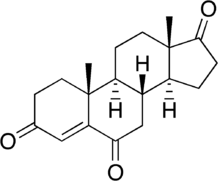4-Androstene-3,6,17-trione
4-Androstene-3,6,17-trione (4-AT; also marketed as 6-OXO or 4-etioallocholen-3,6,17-trione) is a drug or nutritional supplement that may increase the testosterone-estrogen ratio, but has no proven effect on body composition. Its use can be detected in urine.[2][3]
 | |
| Clinical data | |
|---|---|
| Routes of administration | oral |
| Legal status | |
| Legal status |
|
| Identifiers | |
IUPAC name
| |
| CAS Number | |
| ChemSpider | |
| UNII | |
| Chemical and physical data | |
| Formula | C19H24O3 |
| Molar mass | 300.39 g·mol−1 |
| 3D model (JSmol) | |
SMILES
| |
InChI
| |
| | |
4-AT is a potent irreversible aromatase inhibitor that inhibits estrogen biosynthesis by permanently binding and inactivating aromatase in adipose and peripheral tissue.[4][5][6] Aromatase is responsible for the conversion of testosterone to estradiol. Blocking aromatase causes the body to decrease in levels of estradiol, which then results in increase of LH and consequently, testosterone. Since testosterone has myotropic activity and estradiol does not, elevated testosterone levels increase muscle mass. However, there appear to be no human or animal studies testing the hypothesis that 4-AT will produce an anabolic effect.
4-AT is also used by steroid or prohormone users to counteract estrogen level increases caused by aromatization during their steroid cycle. This helps minimize side effects such as gynecomastia but can lead to acne. Also, after a steroid cycle, the compound may be used to shorten the recovery from the testicular suppression that can be the result of the use of steroids.
Baylor University conducted an eight-week study to determine the effects of 300 mg or 600 mg of 4-AT in resistance-trained males. Compared to baseline, free testosterone increased by 90% for 300 mg group and 84% for 600 mg group, respectively. Also dihydrotestosterone and the ratio of free testosterone to estradiol increased significantly. The report concluded that "[t]he results of this study indicate that eight weeks of 6-OXO supplementation had no effect on body composition or clinical safety markers, but incompletely inhibited aromatase activity and significantly increased endogenous DHT levels that were attenuated after a three-week washout period".[7][8] This study did not utilize a control group and was funded in part by two producers of commercial 4-AT.[7][8]
In a FDA Warning Letter dated July 7, 2006, the U.S. Food and Drug Administration (FDA) argues that marketing of 4-AT violates the Federal Food, Drug, and Cosmetic Act and as such products containing it are adulterated by legal definition.
In 2008, Health Canada issued a warning that 4-AT had a health risk related to blood clotting and recommended all users immediately cease use.[9]
References
- "The World Anti-Doping Code: The 2012 Prohibited List" (PDF). World Anti-Doping Agency. Archived from the original (PDF) on 2012-05-13. Retrieved 2012-07-17.
- Van Thuyne W, Van Eenoo P, Mikulcíková P, Deventer K, Delbeke FT (2005). "Detection of androst-4-ene-3,6,17-trione (6-OXO) and its metabolites in urine by gas chromatography-mass spectrometry in relation to doping analysis". Biomed. Chromatogr. 19 (9): 689–95. doi:10.1002/bmc.496. PMID 15828056.
- Deventer, K; Vaneenoo, P; Mikulcikova, P; Vanthuyne, W; Delbeke, F (2005). "Quantitative analysis of androst-4-ene-3,6,17-trione and metabolites in human urine after the administration of a food supplement by liquid chromatography/ion trap-mass spectrometry". Journal of Chromatography B. 828: 21. doi:10.1016/j.jchromb.2005.08.024.
- Numazawa M, Tsuji M, Mutsumi A (1987). "Studies on aromatase inhibition with 4-androstene-3,6,17-trione: its 3 beta-reduction and time-dependent irreversible binding to aromatase with human placental microsomes". J Steroid Biochem. 28 (3): 337–44. doi:10.1016/0022-4731(87)91028-4. PMID 3657156.
- Covey DF, Hood WF (1981). "Enzyme-generated intermediates derived from 4-androstene-3,6,17-trione and 1,4,6-androstatriene-3,17-dione cause a time-dependent decrease in human placental aromatase activity". Endocrinology. 108 (4): 1597–9. doi:10.1210/endo-108-4-1597. PMID 7472286.
- Hsueh AJ, Erickson GF (1978). "Glucocorticoid inhibition of FSH-induced estrogen production in cultured rat granulosa cells". Steroids. 32 (5): 639–48. doi:10.1016/0039-128X(78)90074-0. PMID 734698.
- Rohle D, Wilborn C, Taylor L, Mulligan C, Kreider R, Willoughby D (2007). "Effects of eight weeks of an alleged aromatase inhibiting nutritional supplement 6-OXO (androst-4-ene-3,6,17-trione) on serum hormone profiles and clinical safety markers in resistance-trained, eugonadal males". J Int Soc Sports Nutr. 4: 13. doi:10.1186/1550-2783-4-13. PMC 2100070. PMID 17949492.
- "The science of 6-OXO". Muscle & Fitness. July 2004.
- "Health Canada warns consumers not to use the dietary supplements 6-OXO and 1-AD due to potential serious health risks". Health Canada. June 18, 2008.